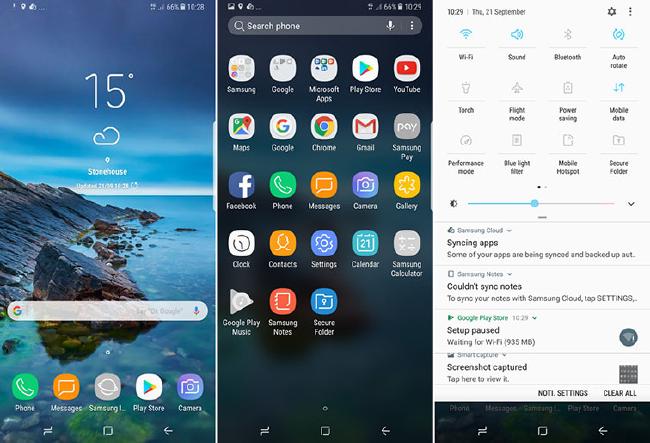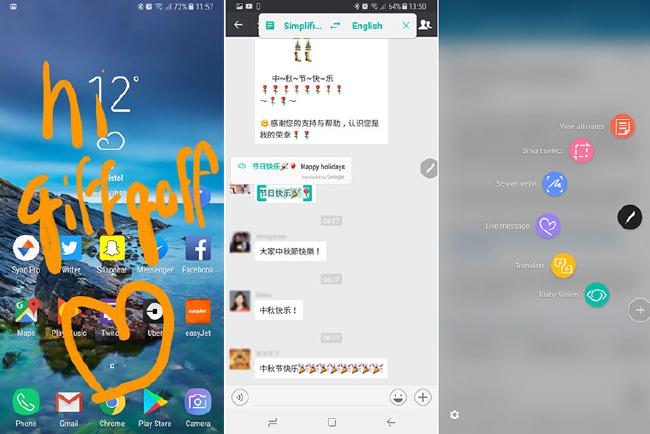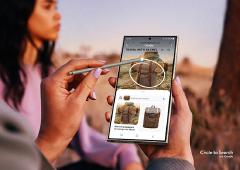Categories
Note 8 review: tested underwater, battery and more
8 minute read
The Samsung Galaxy Note 8 is expensive at £869, but it justifies its price with a modern design, top-notch camera and blazing performance. Yet it’s not without its flaws too, with some odd design choices and lacklustre software. Let’s get into the meat of it with our full review!
Design
The Note 8 is exactly what you might imagine: a combination of the modern, bezel-free design of the Galaxy S8 with the larger frame and S Pen of the Note series. The Note 8 is actually just a bit bigger than the Galaxy S8, with a 6.3-inch AMOLED screen, so the stylus and improved hardware is the bigger difference here. Our review unit comes in gold, and black is also available.

With such small bezels, there’s no room for physical buttons or a fingerprint reader, so instead Samsung rely on a touch-sensitive virtual home button and a fingerprint reader on the back, near the camera. The placement of the latter is just as awkward as it was on the S8, but you can get used to it. Other login options include voice passwords, iris scanning and face unlocking, so you at least have alternatives to traditional PINs.

The Note 8 sports IP68 water resistance, allowing it to stand up to common hazards like sinks and swimming pools. We tested the Note 8’s water resistance ourselves, as you can see in the video below.
The phone recharges using USB-C and comes with a 3.5mm headphone jack at the bottom of the phone. The S Pen silo remains on the bottom as well, on the right side for rapid deployment by right-handed users.

The top of the phone contains a tray for the nano SIM card and Micro SD card; in some territories the Micro SD card section can accommodate a second SIM card instead.

The left side of the phone has three buttons: volume up, volume down and Bixby, the Note’s AI assistant.

Meanwhile, the right hand side has only the power button.

The back of the phone has two rear cameras; we’ll cover these in more detail in our camera section later!
Hardware
The Note lineup has always counted bleeding-edge hardware as one of its strongest features, and that continues with the Note 8. Samsung’s Exynos 8895 processor is very much the equal of the popular Qualcomm Snapdragon 835 processor we’ve seen in most other flagships this year, and this is backed with a generous 6GB of storage and 64, 128 or even 256GB of expandable storage. The screen is the largest of any flagship this year, with a span of 6.3 inches across the diagonal, although the resolution is the same as the smaller S8. However, you do pay for these high-end specs, with the highest SIM-free price of any Android flagship in 2017 of £869.
Hardware comparison
Note8
- CPU: Exynos 8895
- RAM: 6GB
- Storage: 64 / 128GB + mSD
- Display: 6.3" 1440p
- Battery: 3300mAh
- Camera: Dual 12MP | Selfie 8MP
- OS: Android 7.1
- Price: £869
Galaxy S8
- CPU: Exynos 8895
- RAM: 4GB
- Storage: 64GB + mSD
- Display: 5.8" 1440p
- Battery: 3000mAh
- Camera: Dual 12MP | Selfie 8MP
- OS: Android 7.0
- Price: £649
LG V30
- CPU: Snapdragon 835
- RAM: 4GB
- Storage: 64GB + mSD
- Display: 6" 1440p
- Battery: 3300mAh
- Camera: Dual 16MP | Selfie 5MP
- OS: Android 7.1
- Price: £799
HTC U11
- CPU: Snapdragon 835
- RAM: 4GB
- Storage: 64GB + mSD
- Display: 5.5" 1440p
- Battery: 3000mAh
- Camera: 12MP | Selfie 16MP
- OS: Android 7.1
- Price: £589
In my weeks with the Note 8, I never encountered any performance concerns. While past versions of Samsung’s TouchWiz UI have occasionally bogged down, the Note 8 has remained lightning quick throughout. Apps load quickly and stay in memory for a long time, so you’re rarely left waiting. Even in the most intense 3D games, the Note 8 soldiered on unencumbered.

Above: The Note 8 has a much bigger screen than last year’s S7 Edge, more due to its modern tiny-bezelled design than its increased physical size.
Charging & Battery Life
In our testing, the Note 8 easily lasted a day, often stretching into the next with judicious use. The extra wiggle room is welcome, but you’ll still likely charge your phone each night in order to guarantee a full day of use. You can see how long the Note 8 lasts in our battery test video below!
The Note 8 supports Samsung’s Adaptive Fast Charging specification, akin to Qualcomm’s Quick Charge. This allows the phone to refill its 3300mAh battery in about one hour and 45 minutes using the charger that comes in the box, which is a little behind competing solutions from OnePlus and Oppo. Another wrinkle is that the phone won’t fast charge while the screen is on, which is worth remembering when you only have a few minutes to recharge.
Fast wireless charging is also supported, and takes about two hours and fifteen minutes to complete. That’s a little slower than wired charging, but much faster than the original Qi wireless charging specification.
The Note 8 has a USB-C charger, and comes with both a USB-C to full-size USB adapter and a USB-C to Micro USB adapter in the box. This makes it easy to connect older peripherals, including SD card readers, USB drives and so on.
Camera
Let’s start this section with a simple statement: the Note 8 has the best camera I’ve ever used on a smartphone. It starts up incredibly quickly, focuses even faster and produces consistently excellent results with clear detail and vibrant colour.
The Note 8 comes with the now-familiar dual 12-megapixel rear camera setup, with one wide-angle lens and one telephoto lens; exactly the same idea as the LG G6 and OnePlus 5. The difference is in Samsung’s execution: the company has some of the best image processing in the world, with the possible exception of Apple and Google. This ISP excellence results in incredibly sharp photos, with plenty of captured detail. This is particularly noticeable on the 2x zoom lens, which produces far clearer images than the OnePlus 5 in similar low-light conditions.
Above: Monaco, Nice, Bristol
Samsung’s camera app is also worth mentioning. It has a bevy of modes and options, but these are wisely kept out of view until called upon. You can use gestures to quickly swap between the front and rear camera or take a selfie, and there are a wide assortment of filters and silly effects if you like that kind of thing. More importantly, the pro mode is excellent, giving you the ability to experiment with different ISO levels, apertures, white balance, exposure, metering and more.
Above: Nice, Nice, standup mathematician Matt Parker (!!)
Apart from my own testing, DxOMark have declared the Note 8 as the joint-highest performer in their comprehensive camera tests. The phone received a score of 94, tying it with the iPhone 8 Plus.
Above: 100% crop in the middle of the night with the 2x zoom lens. Not perfect, but not bad either!
You can get a better look at some new photo and video samples in our video below!
Software
The Note 8 comes with the latest version of Samsung’s TouchWiz UI, which reskins Android Nougat and adds a laundry list of features. The experience feels smoother here than on last year’s phones, and Samsung’s additions largely make sense.

The Bixby assistant is one of the phone’s stand-out features, so much so that Samsung have dedicated an entire button to summoning her. Bixby can be used to perform plenty of tasks of the form “Open [app] and [action]"; you can send emails, take photos, capture screenshots, adjust settings and many other things. However, the assistant seemed a little less canny than Siri or the Google Assistant in my testing, frequently misunderstanding my requests or being unable to perform an action. Ultimately, the number of times that I successfully used Bixby was heavily outweighed by the number of times that I summoned her accidentally. Darn you, Bixby button!
The other major feature of the Note 8 is its S Pen stylus, which as mentioned before is one of the key differences between the Note 8 and the similarly-sized Galaxy S8+. You can use this stylus for taking notes or sketching, marking up screenshots, translating text and so on. One of my favourite features was being able to take notes without turning on the phone; just release the S Pen with the screen turned off and you can start taking notes immediately. I wasn’t expecting to love the S Pen, but I think I’ll miss it after I return the Note 8!

The Note 8 runs Android 7.1.1, just one major release behind the current 8.0 Oreo standard. Samsung aren’t usually quick to upgrade their phones to new Android versions, so it may be 2018 before an update arrives.
Wrapping up
As good as the Galaxy Note 8 is, it’s hard to give an outright recommendation for a phone that costs almost £900 outright or £42 per month. There are plenty of other phones that feature beautiful designs, top-notch cameras or bleeding-edge performance — the OnePlus 5, the Galaxy S8 and the Google Pixel remain excellent choices. However, the Note 8 combines all of these qualities into a single excellent phone, despite occasional missteps. For those that want the best of the best, the Note 8 is hard to beat.





